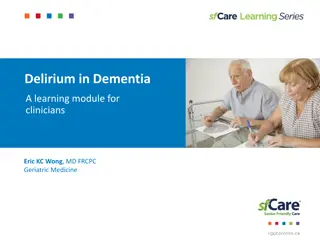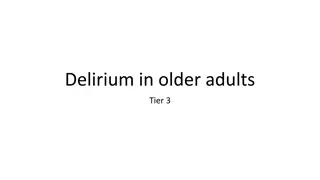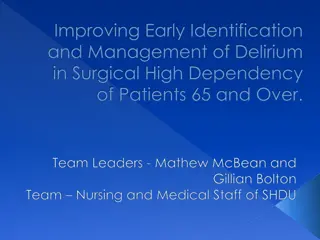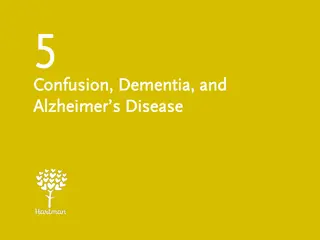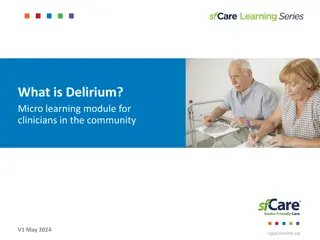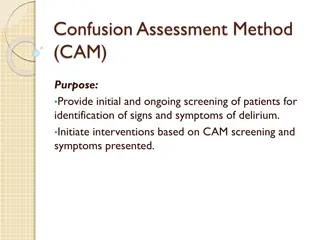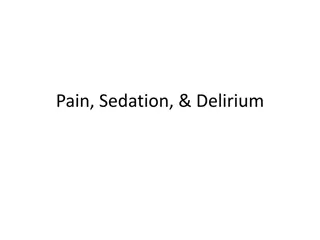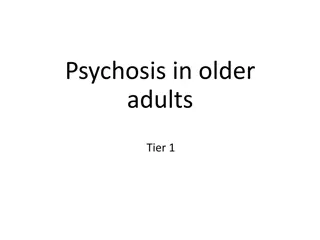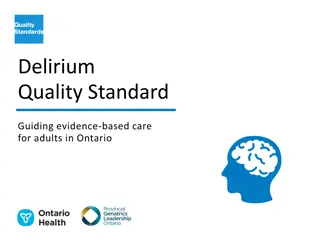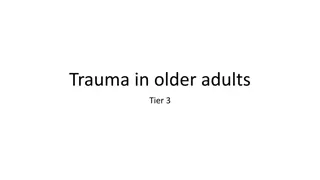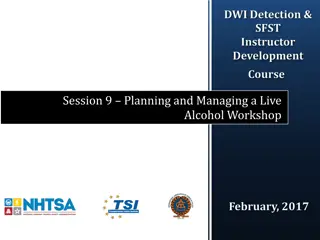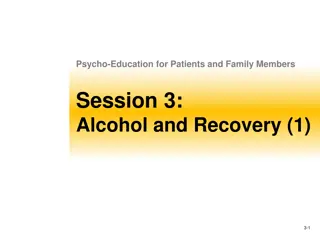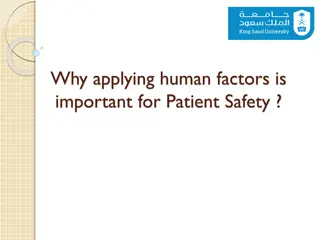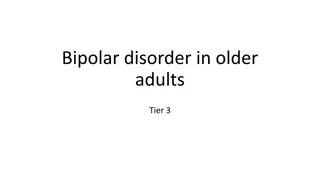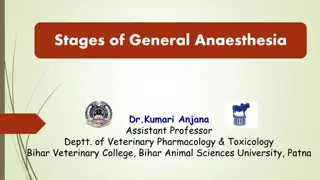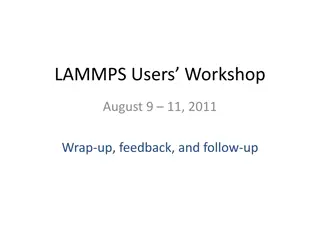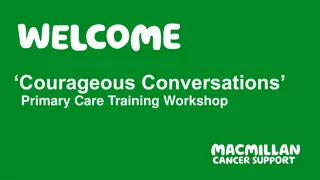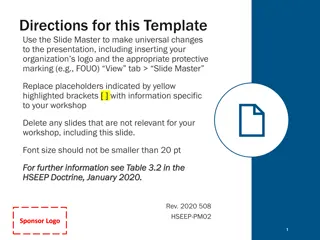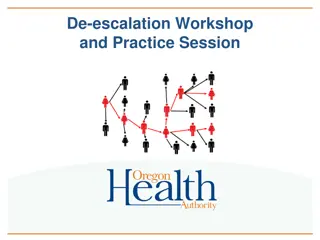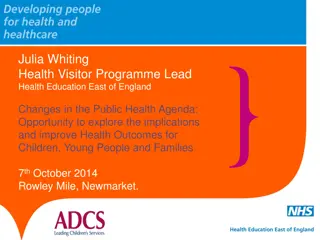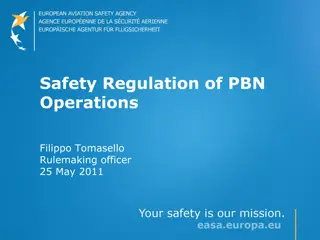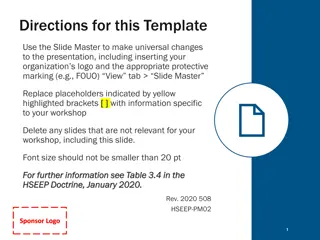Delirium: Underrecognized, Undertreated, and Deadly Workshop Insights
Delirium is a serious condition frequently seen in advanced illness and palliative care settings. It is often underrecognized and undertreated, leading to detrimental outcomes such as increased mortality and healthcare costs. Understanding the symptoms, prevalence, outcomes, and impact of delirium is crucial for healthcare providers to improve patient care and outcomes. This workshop explores the recognition, management, and implications of delirium in hospice and palliative care, emphasizing the importance of early identification and comprehensive treatment approaches.
Download Presentation

Please find below an Image/Link to download the presentation.
The content on the website is provided AS IS for your information and personal use only. It may not be sold, licensed, or shared on other websites without obtaining consent from the author. Download presentation by click this link. If you encounter any issues during the download, it is possible that the publisher has removed the file from their server.
E N D
Presentation Transcript
Delirium: Underrecognized, Undertreated and Deadly Coleman Foundation Winter Workshop February 28, 2013 Andrea Bial, MD Joanna Martin, MD
Objectives Learning Objectives 1. Understand how to recognize delirium in the hospice and palliative setting. 2. Be able to identify possible factors contributing to patients delirium. 3. Incorporate best evidenced-based medicine in treating delirium in hospice and palliative care settings. Content Bullets 1. Recognize agitation, confusion, altered level of consciousness, hallucinations, restlessness and other behaviors associated with delirium in patients with advanced chronic illness. 2. Understand when to pursue reversible causes of delirium and when to forgo evaluation and focus on comfort. 3. Be able to use both pharmacological and nonpharmacological interventions to treat delirium in patients with advanced chronic illness.
Delirium: Whats Going On? Pathophysiology not well understood Thought to be deficit of acetylcholine (e.g., anticholinergic drugs as precipitant) and/or excess of dopamine (that s why levodopa can cause & Haldol can help) Other neurotransmitters (GABA, serotonin, norepinephrine, melatonin, others) and cytokines may also be involved. Inouye 2006; Irwin 2013
Delirium: Prevalence ~ to of advanced cancer patients admitted to the hospital have delirium. 85-90% of all patients experience delirium in the hours or days before death. Very common in hospitalized older patients 33% presenting to ER 14-24% on admission 15-53% post op 70-87% ICU Inouye 2006;LeGrand 2012; White 2007
Delirium: Prevalence in Palliative Care 2013 Literature Review in Palliative Medicine: 13-42% prevalence at admission to palliative or hospice units 26-62% prevalence at some point during hospitalization (in palliative or hospice unit)
Delirium: Outcomes Increased hospitalized mortality (25-75%) Increased 1-year mortality (40%) Increased LOS (2x) Increased hospital complications (incontinence, falls, pressure sores) Increased institutionalization (2-3x) Increased healthcare costs (STAT) Irwin2013
Delirium: Recognition Early identification of risk factors can reduce occurrence. Early recognition of delirium can reduce duration (and potentially identify causative/contributing factors). FOR LEARNERS: Lecture format adequate for knowledge about delirium, but not to change provider behavior or improve outcomes. Need interactive sessions and leaders using clinical pathways and assessment tools. Inouye1993, Yanamadala2013
Why is delirium overlooked? Fluctuating nature Overlaps with dementia Lack of formal cognitive assessment Under appreciation of clinical consequences Not considering the clinical diagnosis important
Types of Delirium Hyperactive: Agitated; repeated (purposeless) limb movements, restless, trying to get out of bed, hallucinations, . Hypoactive Quite, withdrawn; may give monosyllabic answers to simple questions, follow simple commands Mixed
Predisposing Risk Factors UPON ADMISSION Serious illness (advanced cancer, sepsis, acute kidney failure, ) Cognitive impairment Vision impairment Elderly AFTER ADMISSION Physical restraints 3 medications added Malnourished Urinary catheter placed Inouye1993;1996;1999
An Ounce of Prevention Yale Delirium Prevention Trial : Orientation for cognitive impairment Early mobilization Prevention of sleep deprivation/fragmentation Address vision & hearing impairments Preventing dehydration Inouye 1999
Overlooked Inconsistent use of terminology ( confused, altered mental status agitated, lethargic, ) Objective testing rarely done Confused with depression or dementia (see next slide) Increase the risk of being overlooked: Hypoactive form Fluctuating symptoms Age 80yrs del Fabbro2006
Identifying Delirium Several tools available Confusion Assessment Method (CAM) (94-95% sens/spec) Delirium Rating Scale Delirium Symptom Interview Memorial Delirium Assessment Scale Casarett2001
CAM 1. Inattentive AND 2. Acute Onset w/ Fluctuating Course AND 3. Disorganized Thinking AND/OR 4. Altered Level of Consciousness HAVE TO HAVE #1 & #2 AND THEN #3 AND/OR #4 for positive screen. HINT: IADL Inouye1990
CAM: example questions 1. Inattentive: repeat numbers, days of week/months of the year backwards OR observe staring into space, not keeping track of conversation, etc. 2. Acute/fluctuating: ask pt about confusion OR observe variations in attention, speech, thinking, or pyschomotor activity. (can also ask RN or family) 3. Disorganized thinking: what type of place is this, why are you here, see or hear anything unusual? OR observe if pt disoriented or uses illogical ideas/inappropriate words/rambling conversation. 4. Altered Level of Consciousness: falling asleep during interview, stuporous/comatose, non-communicative? Huang2012
Evaluation (after Identification) In hospitalized patients: History (does pt have dementia? What has been the time course?) Physical Exam (new wounds, neurologic deficits, urinary or fecal retention, new fx, ?) Laboratory Tests (if none recent: wbc, cmp, TSH, B12?) Radiology Tests (CXR, head CT, .?) In palliative (Advanced, Chronically ill) patients, is this terminal restlessness? Inouye2006
DELIRIUM Evaluation Management History NON-AGITATED PATIENT: Non-Pharmacologic treatment AGITATED PATIENT: Non-Pharmacologic & Pharmacologic tx (dementia?) and Physical Exam (head to toe) FOCAL EXAM: Do appropriate next step (e.g.,fever cx) THEN, review meds& Order other tests NON-FOCAL EXAM: Review meds Order addn l tests Treat Findings & Manage symptoms Treat Findings & Manage symptoms
Palliative Patients Irwin2013
Evaluation in Palliative Patients Need to address Goals of Care as it will guide extent of evaluation. Easily addressed: constipation, urinary retention, medication side effect, dehydration More likely to be reversible in younger patients, those without organ failure, and those w/ less cognitive disturbance. May be shorter time until death in those w/ irreversible delrium. Leonard2008
Delirium=Syndrome Delirium is almost always multifactorial Need to identify potential causes Evaluation and treatment is always dependent on GOC
Causes of Delirium 1. Medications New drug Dose too high In withdrawal (e.g., benzodiazepines, psych drugs ) 2. Infection 3. Dehydration 4. Metabolic Abnormalities Irwin2013;LeGrand2012
Additional Potential Causes of Delirium in CA pts 1. All of preceding causes, but also 2. Primary or Secondary CNS tumors 3. Toxicity of antineoplastic therapies (chemo, xrt, ) 4. Toxicity of other drugs used in treatment (steroids, anti- nausea drugs, anticonvulsants, ) 5. Paraneoplastic neurological syndromes Caraceni2005
Treatment: Underlying Cause 1. Adjust medication (if able) Any medication that has CNS s.e. can contribute to delirium (especially those w/ hi anticholinergic activity) See next slide 2. Treat infection 3. Address dehydration (IV fluids, sq fluids, oral hydration) 4. Consider fixing electrolyte abnormalities
Medications as Cause Antibiotics Steroids Benadryl NSAIDS Benzos H2 Blockers Digoxin Parkinson s drugs GI (Reglan, Bentyl) Tricyclics Lithium Narcotics Neuroleptics Any drug with anticholinergic properties!
Treatment: Nonpharmacologic Safety of room (minimize bed rails or pad, lower bed, mats on floor) Reorientation (verbal cues, date boards, shades up) Reduce restraints ( official and unofficial ) Family/friends at bedside Supply glasses or hearing aids if appropriate
Treatment: Pharmacologic Caveats NO MEDICATIONS are currently approved by the FDA for management of delirium NO published DB, RCT to guide medication management of delirium. NO consensus: oncology, geriatrics, psychiatry, palliative medicine Goal is to maximize safety
Treatment: Pharmacologic Haloperidol as first drug of choice Can be given IV, IM, SC, PO (pill or liquid) LOW dose to start (0.5mg IV Q6H prn) BEWARE EPIC! Can repeat at 30mins if needed Irwin2013;LeGrand2012
Haloperidol Old, cheap, decades of use Recent trial: 14 centers/4 countries/119 patients w/ delirium in hospice or palliative care: Average daily dose: 2.1mg Most frequent s.e.: somnolence (9%) & urinary retention (5%) 1/3 had net benefit (NCI delirium score) Risks present with ALL antipsychotics Black box warning on all: increased CV or infectious mx when used in dementia-related psychosis Crawford2013, Irwin2013
Other Pharmacologic Treatments Other antipsychotics CAN be used Consider side effects: potentially WANT more sedation, or weight gain, or other effect May use if higher doses needed. Benzodiazepines Can worsen delirium Use as first-line only if alcohol/benzo withdrawal or having seizures Can use as second line (in addition to Haldol) if not achieving adequate response
Delirium in the ICU Estimates range from ~20-90% of patients 10% increase mx for each day of delirium Additional risk factors: Coma Sedatives Neurologic diagnosis Reade2014
Terminal delirium Often referred to as terminal restlessness Characterized by agitation, repeated nonsensical requests ( I need to sit up ), repetitive movements, picking at clothes and sheets. Occurs in up to 85% of patients in the last weeks of life Family/caregiver education is key Can use Haldol first line for symptom management Consider use of benzodiazepines if Haldol ineffective, especially in younger patients
Terminal delirium: Family Support The experience of delirium for families can complicate bereavement Double loss Grief when they lose ability to communicate meaningfully with patient and again when the patient dies Although previous care may have been excellent, if the delirium goes misdiagnosed or unmanaged, family members may remember a horrible death "in terrible pain
Terminal Delirium: Family Support, contd. Families may be ambivalent about medication use: want the pt to be comfortable, but fear lack of communication w/pt or worry that death is hastened. Families should be given ample opportunities to ask questions; information may need to be repeated. If suspect death is near, important to ask family if they want to know prognostic information. Brajtman2005
Patient AB 105yo W in hospice w/ dementia and COPD. Takes Xanax 0.25mg QHS (for years). Called by RN: pt had a night of agitation: was up all night, convinced her son was being held hostage. When son was called to talk to her to reassure her he was ok, she was sure he was being forced to say he was fine. CG couldn t give her any more Xanax (pt refused) and family didn t want to give her Haldol since last time she got it, She was knocked out.
Patient AB: Questions Is this patient delirious? Is this patient having terminal restlessness? What do you recommend for the future? Increase bedtime Xanax Repeat bedtime Xanax dose at start of agitation Use Haldol anyway Have son come over and sit w/ patient
Patient AB What do you do? 1. Increase bedtime Xanax to 0.5mg. 2. Repeat bedtime Xanax dose at start of agitation. 3. Use Haldol anyway, starting at lower dose than before and use at start of agitation. 4. Have son come over and sit w/ patient. 5. 1., 2., 4. 6. 1., 3. 7. None of the above
Patient case #1 Mr. S is an 80 year old NH resident with history of end stage dementia admitted to hospice with history of aspiration pneumonia. Mr. S is usually calm, nonverbal and can sit in the dayroom in his wheelchair. The NH calls you that he has become quite agitated and won t let the CNA give him his bath today.
Patient case #1 cont. . . NH reports patient usually calm and often sits in day room, pleasantly confused at baseline. Exam: VSS with no BM since hospice admission one week ago, patient lying in bed, agitated and moaning, lung exam stable, abdomen distended with bowel sounds; rectal vault filled with stool Meds reviewed: HCTZ, Nifedipine, prevacid, roxanol 5mg q4hrs prn
Is this patient delirious? Acute onset and fluctuating course YES Inattention YES Disorganized thinking Altered level of consciousness YES NO
Patient case #1 Patient is impacted Fleets enema performed with good results Patient straight cathed to check post void residual which was <100cc Meds reviewed: HCTZ, nifedipine and roxanol can cause constipation Meds adjusted Bowel regimen: senna daily
Patient case #1 Patient much more comfortable by the next day He returns to baseline within a few days Hospice team provides a lot of oversight to nursing home care; patient requires close medication monitoring and has ongoing issues with constipation
Patient case #2 Patient is a 50 year old man with metastatic lung cancer admitted to hospice one month ago. Patient is steadily declining and using ativan now multiple times a day for anxiety. His wife contacts you that he is pacing, agitated and combative. At baseline he is usually anxious but can be reassured.
Case 2 continued. . . On exam, he is confused, hyperalert and report seeing ants walking on the ceiling. He is unable to follow your other questions. His exam is remarkable for cachexia and hypoxia. SOB is controlled. Bowels are moving and patient urinating regularly. Meds: ativan (7 doses in past 24 hrs), decadron 4mg, MS Contin 30 bid and roxanol 5mg prn
Is this patient delirious? Acute onset and fluctuating course YES Inattention Disorganized thinking Altered level of consciousness YES YES YES
Patient case #2 Decision made to decrease dose of ativan back to bid and start haldol 0.5 mg bid and q4 hrs prn; give decadron in AM Patient calms down enough to wear oxygen and wife able to manage sx No need for opioid rotation Ends up using haldol 1mg q4hrs ATC Much calmer and comfortable until death one month later
Patient case #2 Decision made to decrease dose of ativan back to bid and start haldol 0.5 mg bid and q4 hrs prn; give decadron in AM Patient calms down enough to wear oxygen and wife able to manage sx No need for opioid rotation Ends up using haldol 1mg q4hrs ATC Much calmer and comfortable until death one month later
Patient Case #3 Patient is a 65 year old woman with stage IV breast cancer in home hospice Family calls to report that patient more confused in past two days and sleeping more
Case #3 continued. . . On exam: VSS, patient is sleepy and able to answer some questions but has trouble tracking conversation and is tangential, no focal neuro deficits noted, exam otherwise unchanged Meds: fentanyl patch and roxanol prn; senna


